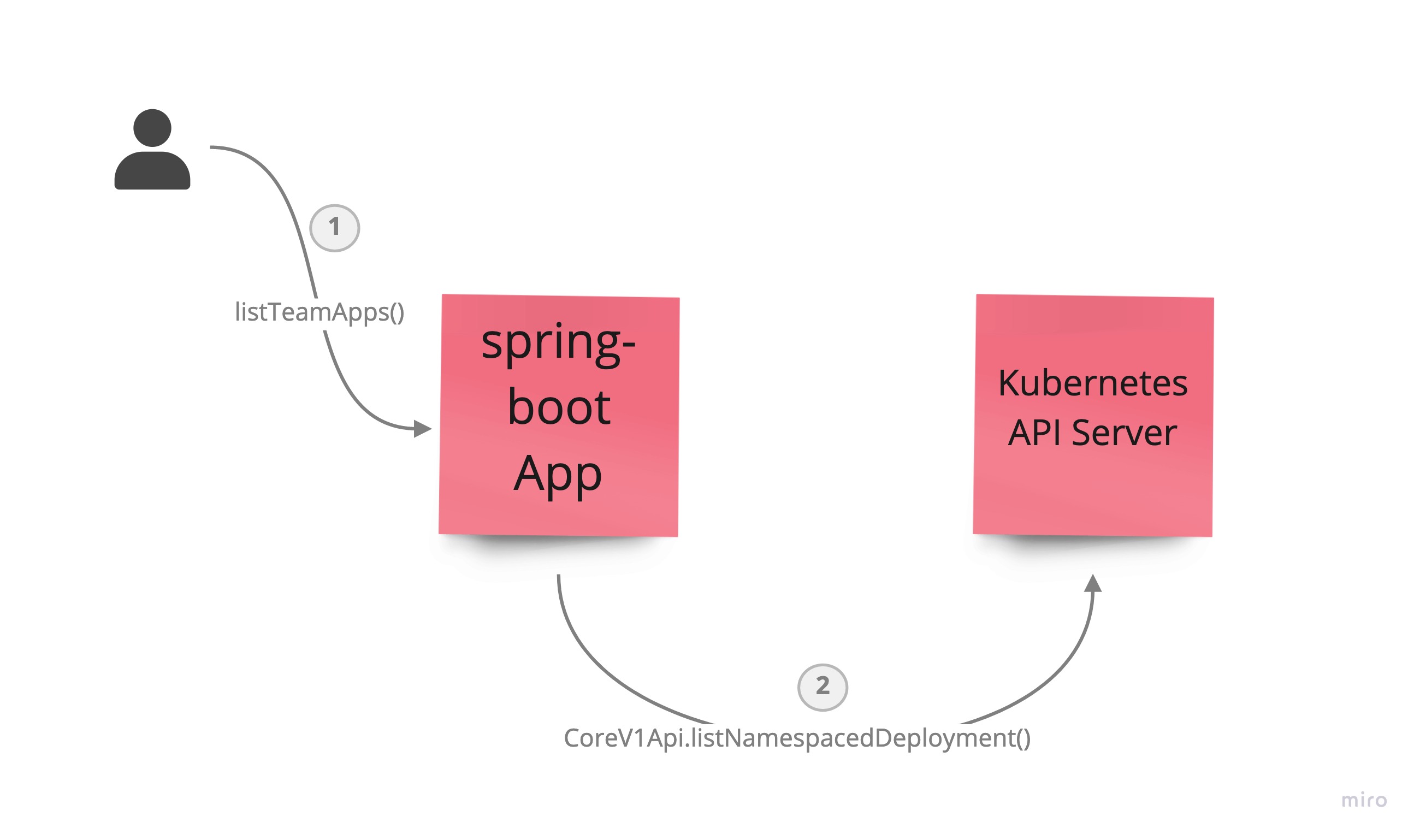What are we going to do?
This post builds on top of Kubernetes with Java - Introduction which relied on synchronous Kubernetes API to get information for apps runnings in Kubernetes cluster. In this post, we will
- Learn when to use synchronous and when to use asynchronous Kubernetes API mechanisms
- Learn how to use asynchronous Kubernetes API to exrtact deployments metadata
- How to use spring-boot profiles to conditionally enable functionality
Synchronous vs asynchronous APIs
Kubernetes API provides two mechanisms to consume information for the clients. The synchronous API is appropriate when you want to access the Kubernetes API infrequently or if it changes rarely on the cluster. As you can imagine, the more requests we make to our app, the more requests it will make to the Kubernetes API, putting pressure on the cluster while it is trying to deal with managing app workloads. This interaction can be visulized like:
The asynchronous API is more appropriate if our app will be accessing the Kubernetes API very frequently. In this scenario, the client (our application) subscribes to change events - also known as creating a watch. The client can then react to these changes in near real-time or simply cache the information locally to use later. This kind of interaciton can be visualized like so:
Using the asynchronous API
The two additional objects we will be dealing with will be io.kubernetes.client.informer.SharedIndexInformer and io.kubernetes.client.informer.cache.Indexer. The informer object is roughly responsible for requesting to watch the deployment listing from the Kubernetes API and then dealing with the change events as they happen in the cluster. The indexer on the other hand is like a local cache of the deployment list and is updated by the informer. Our app will be asking the indexer to list the deployments when we want to see it and it will serve them from its cache.
Creating the informer-factory
To create the informer we need to first instantiate a SharedInformerFactory using the api-client. We can do that by creating a new spring bean in our ApiClientConfig class like so:
@Bean
public SharedInformerFactory sharedInformerFactory(ApiClient apiClient) {
return new SharedInformerFactory(apiClient);
}
Creating the informer and indexer
Next, we will create a new service class called AsynchronousTeamAppsService which implements TeamAppsService.
In the previous post, we created a
SynchronousTeamAppsServiceclass which also implemented theTeamAppsServiceinterface. That class interacted with the Kubernetes API in a synchronous manner. Normally, you would chose only one way to access the Kubernetes API based on your use case.
We will then need to inject api-client, informer-factory, and the namespace objects in our servie instance.
import io.kubernetes.client.informer.SharedIndexInformer;
import io.kubernetes.client.informer.SharedInformerFactory;
import io.kubernetes.client.informer.cache.Indexer;
import io.kubernetes.client.openapi.ApiClient;
import io.kubernetes.client.openapi.apis.AppsV1Api;
import io.kubernetes.client.openapi.models.V1Deployment;
import io.kubernetes.client.openapi.models.V1DeploymentList;
import lombok.SneakyThrows;
import lombok.extern.slf4j.Slf4j;
import org.springframework.beans.factory.annotation.Value;
import org.springframework.context.annotation.Profile;
import org.springframework.stereotype.Service;
import java.util.List;
import java.util.Set;
import java.util.stream.Collectors;
@Slf4j
@Service
public class AsynchronousTeamAppsService implements TeamAppsService {
private final Indexer<V1Deployment> indexer;
private final SharedIndexInformer<V1Deployment> informer;
public AsynchronousTeamAppsService(
ApiClient client,
SharedInformerFactory informerFactory,
@Value("${namespace}") String namespace) {
log.info("Creating asynchronous team-app service, Namespace={}", namespace);
AppsV1Api appsV1Api = new AppsV1Api(client);
informer = informerFactory.sharedIndexInformerFor(params -> appsV1Api.listNamespacedDeploymentCall(
namespace,
null,
null,
null,
null,
TEAM_LABEL,
null,
params.resourceVersion,
null,
params.timeoutSeconds,
params.watch,
null),
V1Deployment.class,
V1DeploymentList.class);
indexer = informer.getIndexer();
}
In the code above, the informer and indexer are setup in our service constructor. Notice, the arguments to the informer are almost the same as our earlier synchronous service calls. We need to keep the reference to the informer object so that we can controll the background event synchronization. We will do that through spring bean lifecycle annotations like so:
@PostConstruct
public void init() {
informer.run();
}
@PreDestroy
public void destroy() {
informer.stop();
}
Listing all teams
Now that we have the informer synchronizing with the Kubernetes API in the background and feeding the indexer cache - we need to implement the listTeams() method.
public Set<String> listTeams() {
return indexer.list()
.stream()
.map(deployment -> deployment.getMetadata().getLabels().get("team"))
.collect(Collectors.toSet());
}
The indexer simply returns a list of V1Deployment objects from its list() method. Once we have a list, we can use the java stream mechanism to transform each item to a team name, adding them to a java set which will take care of duplicates.
Listing team-apps for a team
Implementing the listTeamApps() method is pretty simple as well. Since our indexer has a list of ALL deployments that have the team label, we need to filter the stream to only those where the team label’s value match our given team. Once the list is filtered, we simply map from V1Deployment to TeamApp objects. The relavant code will look like:
public List<TeamApp> listTeamApps(String team) {
return indexer.list()
.stream()
.filter(deployment -> team.equals(deployment.getMetadata().getLabels().get("team")))
.map(this::toTeamApp)
.collect(Collectors.toList());
}
private TeamApp toTeamApp(V1Deployment v1Deployment) {
return TeamApp.builder()
.name(v1Deployment.getMetadata().getLabels().get(APP_LABEL))
.team(v1Deployment.getMetadata().getLabels().get(TEAM_LABEL))
.readyInstances(v1Deployment.getStatus().getReadyReplicas())
.build();
}
Using Spring profiles
Now that we have two beans that implement TeamAppsService interface and our controller is expecting a single instance, we need to instruct Spring to instantiate only one of them. There are lots of ways of doing this - one of them is Spring profiles. By using the @Profile annotations, we can controll which bean gets instantiated and hence injected in our controller. The annotation usage will look like following:
@Profile("async")
public class AsynchronousTeamAppsService implements TeamAppsService { ... }
… and
@Profile("!async")
public class SynchronousTeamAppsService implements TeamAppsService { ... }
When running with async spring profile, the AsynchronousTeamAppsService bean will get instantiated and SynchronousTeamAppsService will not. If not running with that profile (when not specified, default profile is in effect), the opposite will be true. A very thorough write up on Spring Profiles can be found here.
Conclusion
In this post we introduced the asynchronous APIs so that we can use the informer and indexer mechanisms to cache deployment object metadata in the background within our app. In a future post, we might look at how to listen to the change events and react to them in near real-time.
Referenced Code
To see working code from this post (with slight modifications), see the Git repository.

